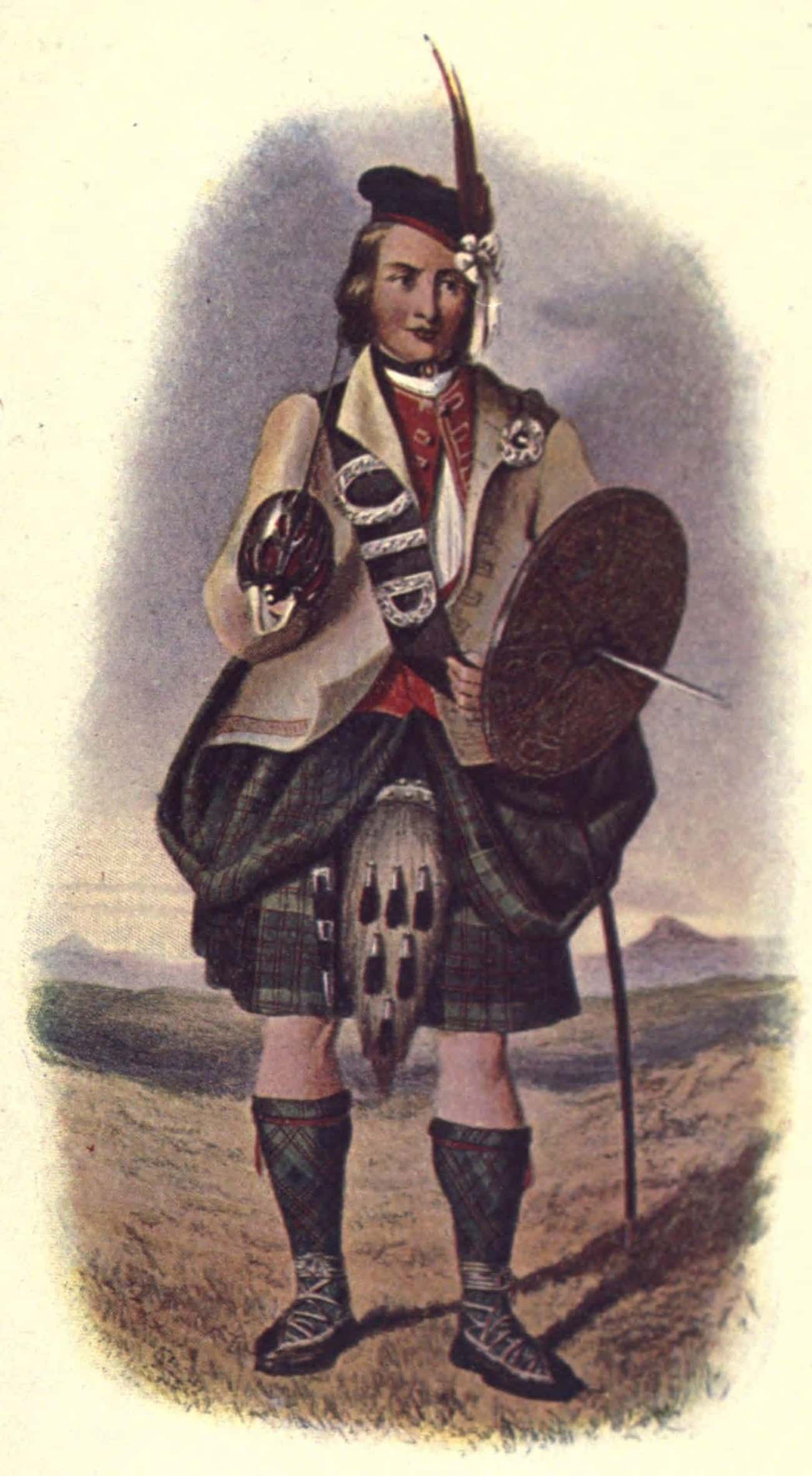The 15 Bloodiest, Most Violent Family Feuds In History
Members Of The Campbell Clan Massacred The MacDonalds Of Glencoe
- Photo:
- Robert Ronald McIan/Public Domain
- via Wikimedia Commons
The Campbells and the MacDonalds were two rival Highland clans in the late 17th century. Theirs was the worst kind of rivalry in Scotland: a cattle rivalry. MacDonalds stole Campbell cattle, and vice versa. Things came to a head in February 1692, when members from Clan Campbell participated in one of the most infamous events in British history: the Glencoe Massacre.
After MacDonalds from Glencoe didn't sign a loyalty oath to the new King William and Queen Mary on time, the government sought to brutally punish the family for their impudence, and make an example of them for other Highland clans. The Campbells were all too eager to take part in the bloodshed.
So, an army of men – including, but limited to, Campbells – traveled to Glencoe and requested hospitality, claiming they needed to camp on MacDonald land. After the MacDonalds had given the group hospitality – food, drink, and entertainment – for nearly two weeks, the men turned on the clan, killing men, women, and children as they slept in their beds. Most of the MacDonalds who managed to flee the scene of frenzied murder ultimately died in the hills, as a result of the bitter February weather. To this day, some claim the Campbells are still cursed for breaking the laws of hospitality.
- Photo:
The Pazzi Conspired To Kill The Medici In The Very Cathedral They Helped Build
- Photo:
- Public Domain
- via Wikimedia Commons
By the late 15th century, Florence was more or less Medici turf. The famous banking family was on the cusp of becoming a dynasty. The problem? The Pazzi, another wealthy Florentine family, didn’t want that to happen.
So on April 26, 1478, members of the Pazzi attacked and attempted to assassinate the two most prominent members of the Medici clan at High Mass in the Duomo, the city’s main cathedral that the Medici themselves had funded. The Pazzi assassins successfully murdered Giuliano de Medici, but his brother Lorenzo managed to escape.
The repercussions were swift: the conspirators were executed and the entire Pazzi family was banished from Florence. For proud Florentines in the 15th century, that was a fate worse than death.
- Photo:
The Hatfield-McCoy Feud Climaxed With The New Year's Massacre
- Photo:
- Public Domain
- via Wikimedia Commons
The war between the Hatfields and McCoys is perhaps the most notorious family feud in American history. Lasting from roughly 1863 to 1891, the decades-long conflict between two proud, rough-hewn Appalachian families began over a hog, of all things. Randolph McCoy – the patriarch of the McCoy family – claimed that a Hatfield scoundrel had stolen one of his hogs. The trial – helped in no small part by the influence of William "Devil Anse" Hatfield – did not go in McCoy's favor. And so the bloodletting began: McCoys murdered and maimed Hatfields. Hatfields murdered and maimed McCoys. Young lovers were torn apart. Lives were extinguished before they began.
The feud came to a bloody climax in the New Year's Massacre of 1888. Hatfields surrounded the home of a sleeping Randolph McCoy in the middle of the night, and released a barrage of bullets. Two of McCoy's children died, though he escaped and his wife barely survived.
The Hatfield-McCoy feud had become so violent, the United States government actually got involved, and the case was taken all the way to the Supreme Court. Eventually, eight Hatfields were sentenced to life in prison, and an allegedly mentally challenged member of the family was executed. After that, the feud fizzled out.
- Photo:
Clan Conflict Led To A Monumental War In 12th-Century Japan
- Photo:
- Utagawa Kuniyoshi/Public Domain
- via Wikimedia Commons
Two of Japan's most powerful clans in the 12th century were the Taira and the Minamoto. One, however, had more power than the other: the Taira basically ran the imperial government. Though the Minamoto had risen against the Taira, it didn't end well for them in 1160. Twenty years later, they gathered their forces again, this time with a vengeance.
War broke out between the two families, with the Minamoto successfully convincing other clans to join their cause. Battles grew and conflict escalated in size until they plagued the country. The war lasted five years. By the time the Genpei War (as we know it today) ended in 1185, tens of thousands of people lost their lives, and a new shogunate was established with the Minamoto in charge.
- Photo:
A Stewart King Served Death À La Douglas At The Black Dinner
- Photo:
- Public Domain
- via Wikimedia Commons
Though the Stewarts had been the Scottish royal family since the 14th century, they didn't command everyone's love and respect by the 1400s. Case in point, the Douglas family rivaled the Stewarts in terms of prestige and power, and they didn't always play nice with the royals. So in 1440, the 10-year-old King James II invited two prominent Douglases (Dougli?) to dinner at Edinburgh Castle, where they were promptly beheaded. (It's unclear the extent to which the child king was involved in this treachery; one account has him pleading for the guests' lives.)
The so-called "Black Dinner" was only one bloody moment in the troubled history between the Stewarts and the Douglases. A few years later, the king himself plunged a knife into William Douglas and tossed him from a window at Stirling Castle. Finally, the conflict came to a head when the Douglases and Stewarts met on the battlefield in 1455. The Stewarts prevailed, establishing a central monarchy that ruled Scotland through the Late Middle Ages.
- Photo:
The Civil War Never Ended For The Lees And The Peacocks
- Photo:
- Public Domain
- via Wikimedia Commons
Texas, 1867. The Civil War ended two years earlier, but that didn’t mean tensions dissolved. Bob Lee, for one, remained an unrepentant Confederate. So when Lewis Peacock was actively collaborating with the Reconstruction government and protecting Union sympathizers, Lee simply could not abide it.
Tensions between the two escalated to the point of bloodshed. Each family amassed various allies in the area, and eventually the U.S. Cavalry had to intervene between the warring clans.
- Photo:
The Graham-Tewksbury Feud Erupted Into Open Warfare In The Wild West
- Photo:
- SMU Central University Libraries
- via Wikimedia Commons
The Grahams and the Tewksburys were two successful ranching families in the Arizona territory at the end of the 19th century. In the beginning, the two families were actually friendly and cooperated with one another. Enter: James Stinson, another rancher who accused the Tewksburys of stealing his cattle.
In a move the Tewksburys would never forgive, he wooed the Grahams to take his side. For an entire decade, the Tewskburys and the Grahams were at war. The conflict featured shootouts, vengeful cowboys, and assassins, the so-called "Pleasant Valley War" claimed at least 25 lives between 1882 and 1892.
- Photo:
The Wars Of The Roses Were Basically A Brutal Family Soap Opera
- Photo:
- Public Domain
- via Wikimedia Commons
Family feuds don't have to be between rival clans. In fact, some feuds erupt within genetic lines. Such was the case of the Wars of the Roses, when no less than the English throne was at stake.
The Houses of York and Lancaster were two branches of the same royal family, and they all descended from King Edward III. So when King Henry VI – a Lancastrian king – proved to be a weak and unstable ruler, his York cousins took advantage and claimed the throne for themselves.
For three decades, England was engulfed in an aristocratic interstitial war, and a bloody family soap opera. Thousands died on and off the battlefields of England during this turbulent period. The throne passed back and forth until 1485, when yet another cousin – Henry Tudor – defeated the Yorkist King Richard III at the Battle of Bosworth Field.
- Photo:
The Percy-Neville Feud Anticipated The Wars Of The Roses
- Photo:
- John Augustus Atkinson/Public Domain
- via Wikimedia Commons
The Percy and Neville families were two of the most powerful houses in the north of England by the middle of the 15th century. With great power, however, came great tension — they mistrusted one another and each jockeyed for power, alliances, and influence.
Tensions first broke out into actual physical confrontation in August, 1453, when the two families fought after a Neville wedding. Though the crown intervened in the feud later that year, it actually did little good: their bitter rivalry echoed in the ensuing Wars of the Roses, with each family taking sides and escalating the conflict.
- Photo:
The Sutton-Taylor Feud Was A Texas-Style Family War
- Photo:
- Frederic Remington/Public Domain
- via Wikimedia Commons
In 1868, Texas was an untamed land where the law wasn't always held in the highest regard. The Taylors – bleeding-heart Confederates – bit their thumb in the face of U.S. federal law. In the years following the Civil War, racial tensions were high, especially in the South. In 1866, a member of the Taylor family fired the first shot of the feud: he killed an African American man at a dance. In the following years, Taylors would shoot both African Americans and U.S. soldiers, symbols of the Reconstruction government that the Taylors loathed.
The Suttons, on the other hand, were lawmen, and the Taylors became a thorn in their side. So, when a Sutton killed a Taylor suspected of being a thief, the blood feud began to spiral out of control. Dozens of people on both sides died, and the feud did not end until 1876, when Texas Rangers intervened and put an end to it.
- Photo:
One Of The Bloodiest Days In Mafia History Happened Because Of A Family Rivalry
- Photo:
- State Library and Archives of Florida/Public Domain
- via Wikimedia Commons
The criminal underworld can be a patriarchal society. That was certainly true in the 1920s and 1930s, the heyday of American organized crime. Chicago was a city divided between Al Capone on the South Side and George "Bugs" Moran on the North Side. But it wasn't just business, it was personal.
Moran was vocal about his dislike of Capone, and attempted to shame him for dealing in prostitution. Tensions rose, and Moran and Capone associates became involved. Everything came to a head on Valentine's Day 1929, when Capone (allegedly) orchestrated a massacre of Moran's men.
- Photo:
One Medieval Clan Feud Was Settled In A Trial By Combat
- Photo:
- William Hole/CC BY-SA 3.0
- via Wikimedia Commons
In 14th-century Scotland, Clan Chattan sought to take out a rival clan that was standing in the way of its territorial expansion. Historians still don't completely agree on who this rival clan was, but it may have been Clan Cameron.
So, in 1396, King Robert III agreed that a kind of spectator battle should take place. Each clan was to pick 30 of its best men to represent them on the field of battle, and they unleashed hell on one another. At the end of the so-called Battle of the North Inch, Clan Chattan was victorious.
- Photo:
The Black Donnelly Massacre Proves That Not All Canadians Are Nice
- Photo:
- Manuel Cabral y Aguado Bejarano/Public Domain
- via Wikimedia Commons
In this feud, a whole family was on one side, and an entire town was on the other. The so-called "Black Donnellys" were an Irish immigrant family that settled outside Biddulph, Ontario, in 1842.
Unfortunately, the Donnellys often had run-ins with the law in their quest for prosperity, and these incidents began to enrage members of the township. So, in 1880, members of the town took the law into their own hands and attacked the Donnelly family farm, killing five members of the clan.
- Photo:
Henry II Ran The Angevin Empire - But He Couldn't Manage His Family
- Photo:
- Amos Cassioli/Public Domain
- via Wikimedia Commons
Henry II is remembered as one of history's greatest kings who presided over an Angevin Empire that included territory in England, France, and Ireland. But despite his success in expanding royal authority, his family life was a hot mess. For one, his wife - the beautiful and brilliant Eleanor of Aquitaine - made a game of challenging him, and often got their sons in on the fun, too. No less than three of Henry's sons rebelled against him alongside Queen Eleanor in 1173. Henry was able to put down the rebellion and smooth things over.
Two of their sons went on to rule after Henry's death in 1189: Richard the Lionheart succeeded his father and ruled until 1199, and then his younger brother John ruled until 1216. Both brothers fought and stumbled their way into the Robin Hood legends.
- Photo:
The Bonville-Courtenay Feud Involved Young Men Who Had Nothing Better To Do Than Fight
- Photo:
- Paul Mercuri/Public Domain
- via Wikimedia Commons
In the years leading up the Wars of the Roses, King Henry VI's power was waning, especially in the local politics of the realm. Two noble families – the Bonvilles and the Courtenays in western England – were thus able to feud with very little repercussions.
The Bonvilles and the Courtenays were rivals in Devon, and their jockeying for power and influence often led to bloodshed. Violence wasn't limited to the families, however. Associates often got caught in the cross-fire, like Nicholas Radford, who worked with the Bonvilles. When the Wars of the Roses finally broke out, it gave the two families reason to champion opposite causes: the Courtenays supported the House of Lancaster, while the Bonvilles threw their lot with the Yorks. Many members of both families died, and the feud continued until the Earl of Devon was imprisoned for the murder of Nicholas Radford.
- Photo:



































